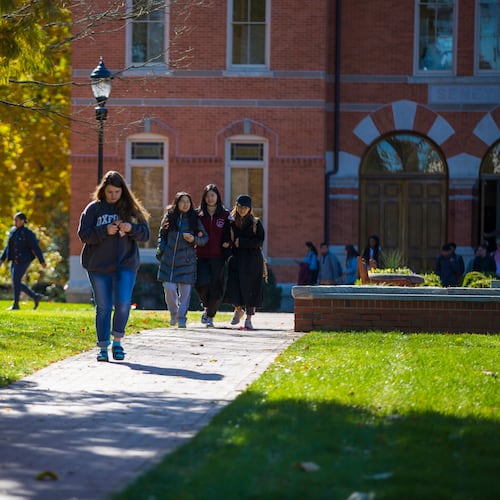Some parents of dual enrolled high school students aren't happy about a bill limiting the program's scope. House Bill 444 restricts which students can take dual enrollment and how many classes they can take – all in an effort to tamp down on the program's soaring price tag.
Without any new regulations, dual enrollment is on track to cost Georgia $144 million a year. (My own note here: We have no idea what that money is producing as we haven't done the necessary research on outcomes of kids taking college classes while still in high school.)
One mother suggested to me the program could save millions by eliminating private colleges that cost taxpayers far more in dual enrollment than public campuses. She delved into the state audit on dual enrollment costs and came up with some advice for lawmakers that I am sharing here.
I am not using the woman’s name over her concerns about repercussions to her own dual enrolled high schooler.
Here are the parent’s comments on HB 444:
House Bill 444 is using a sledgehammer to fix a financial problem that needs a carving knife.
I've reviewed several articles and documents including the Special Examination Report No. 17-09 Georgia Department of Audits and Accounts Performance Audit Division – Dual Enrollment. The audit was requested by the Senate Appropriations Committee.
After reading it, I have questions as a parent and taxpayer.
Why is there such a discrepancy in the per credit hour payments Georgia Student Finance Commission paid to colleges?
This is the link to the GSFC Dual Enrollment tuition allowance award amounts.
In 2019, there were 23 private campuses in the DE program. Private schools are paid $250/credit hour. This per credit hour rate is higher than 85% of the allotted per credit hour rates at University System of Georgia public colleges.
Additionally, private campuses get $150 more per credit hour than each of the 22 schools in the Technical College System of Georgia.
To put it another way, 45 of the 49 Georgia postsecondary institutions participating in the DE program get paid less per semester hour than do private schools.
The winner of highest numbers of DE credit hours goes to Georgia Military College. GMC is an "independent/private institution."
According to the audit, GMC had over 25,000 DE credit hours in FY2017. That's about $6 million in tuition paid by Georgia taxpayers.
I was surprised the DE program included private colleges at all. It would seem to make more sense for the Georgia taxpayer-funded DE program to limit itself to its own public colleges. At least if DE payments are going to GA colleges it's going back into the same pocket – unlike private institutions. If private colleges are even to be admitted to the DE program, why are they so heavily compensated in their per credit hour rate?
When I looked at the FY 2019 dual enrollment institutions, I was surprised to see the vast disparity in their admission standards.
All University System of Georgia public institutions require a minimum 3.0 GPA and a minimum score for SAT/ACT.
No so with the private campuses. The audit states: "Of the six private/independent institutions with the highest DE participation, two allow a GPA of less than 3.0" and the private institutions "are less likely to require a minimum score on college readiness or placement tests."
For example, Truett McConnell University's admission criteria for regular students is at least a high school GPA of 2.0 and combined SAT of 800 or higher. A score of 800 on the SAT is low: approximately the bottom 10th percentile nationally.
I'm not saying struggling high school students should not ever be allowed in college. However, Georgia taxpayers should not be paying their college tuition. As a taxpayer, I believe our representatives should invest our money in something with better odds than the 10th percentile.
The audit shows that 65.6% of the student population at TMU consists of DE students.
So, 66% of the tuition received at TMU – a private university – is paid by Georgia taxpayers. TMU is admitting students who could be in the bottom 10th percentile academically and receiving millions of dollars in taxpayer money to cover their tuition. The audit data puts their FY 2017 dual enrollment tuition payments at approximately $3,750,000.
Is HB 444 increasing oversight of the program as maintained?
DE now limits payments to 15 hours/semester – a standard full-time college course load. Yet, the audit indicated, "Georgia Student Finance Commission paid invoices for 201 students who received aid in excess of 15 credit hours per academic term, with one student taking 58 credit hours per term."
I don't think there's even enough waking hours in a week to make taking 58 credit hours per term possible. This is clearly abuse of the program, yet no safeguards are being instituted to monitor it, just "guardrails," as the bill's sponsors like to say.
As stated, the dual enrollment program now limits students to 15 credit hours per term.
However, according to the audit, "Georgia Student Finance Commission allows students to enroll in multiple institutions and provides the funding up to the maximum 15 hours for each institution."
That seems like a loophole that could and should be closed to reduce costs. HB 444 doesn't offer a provision to close this loophole.
Why is it so easy to get into dual enrollment?
The purpose of the DE program has never really been defined. That was a main point in the audit, and it was addressed clearly in line 19 of HB 444.
But, logically, the funding was intended to provide higher-achieving students, students with promise, access to postsecondary education in situations where their high school did not have the resources or ability to offer advanced classes, AP classes, career training etc.
The intention could not have been for Georgia taxpayers to provide postsecondary tuition for all students, no matter what their academic achievement level was. This can be inferred by the program's earlier name, "Move On When Ready."
That being said, it must be most uncommon for a 9th grader to legitimately be ready for college unless that college has very low standards, yet wants some free state money.
How did 9th graders ever even get included in this funding?
HB 444 does seek to eliminate 9th grade students and limit 10th grade students unless they meet certain high academic standards. If Georgia taxpayers are going to invest in technical training and higher education in its children, it only makes sense to use that investment wisely and for those students most likely to succeed.
After all, doesn't Georgia want to nurture its students to be employable functioning members of our state? The HOPE and Zell Miller Scholarships have minimum grade and test score requirements to receive and retain funding. Why aren't there minimum admission requirements at all DE participating institutions?
Dual enrollment is not lottery funded. Many people don't realize dual enrollment is funded by taxpayers and not by the lottery funds that pay for HOPE. If you watch General Assembly videos of the HB 444 discussion, you will realize that this, sadly, includes some of our state lawmakers.
"Don't worry, current DE students are grandfathered in!" is a lie.
In speaking to the Senate on Jan. 28, bill sponsor Sen. Brian Strickland said, "And to make sure we are not changing the rules in the middle of the game, we provide a grandfathering provision for students that have already embarked on dual enrollment under our current law."
This is where it gets personal for me. I am a mother of a high school junior who started dual enrollment this year and will be limited to 17 more hours of covered DE in her senior year of high school if HB 444 passes.
Her class choices this year were strategically chosen with the intent the program would function the same next year. Many colleges have already started advisement for next fall. Choosing classes for next fall/spring is complicated by the likelihood of the rules changing "in the middle of the game."
My daughter was to go full-time next year to college as she has maxed out her high school classes this year while being dual enrolled part-time. Now it seems she will have to sign up for high school electives she doesn't even need just to kill time.
The baby has gone out with the bathwater on this one.
About the Author
Keep Reading
The Latest
Featured



